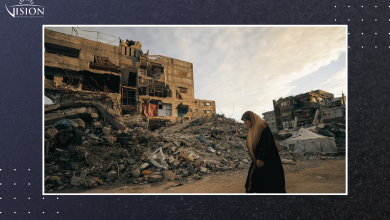The War on Gaza and Its Economic Repercussions for the Israeli Occupation

Raghad Azzam
As Israel’s war on the Gaza Strip enters its eleventh month amidst stalled ceasefire negotiations—implying the potential continuation of hostilities—and with the right-wing government led by Netanyahu propelling the situation toward further escalation that may extend beyond Gaza to other arenas, observers have increasingly turned their attention to Israel’s internal economic conditions and the impact of its longest war on its economic infrastructure. The protracted conflict has not only undermined Israel’s image as a safe haven for Jews worldwide but has also posed a direct threat to the economic achievements it has long endeavored to enhance and develop. This is particularly significant given that Israel recently experienced internal unrest due to controversial judicial reforms debated in the Knesset prior to the Gaza war, which were perceived at the time as weakening the democratic system. These reforms ignited massive street protests and led to civil disturbances that reverberated through Israel’s economy, especially with the Histadrut (Israel’s General Federation of Labor) joining the protests.
This report serves as a continuation of a previous analysis prepared at the outset of the war, aiming to present and scrutinize the economic losses Israel has incurred since October 7, 2023. It will focus on the latest economic developments within Israel to assess the extent of the impact of the ongoing conflict over nearly a year, utilizing available statistical data on key economic indicators.
First: Economic Growth
The extended duration of the war has intensified economic pressures following the complete halt of the tourism sector, a slowdown in maritime shipping, the closure of numerous small businesses, and the impairment of others. Since the onset of the war, approximately 46,000 companies have closed their doors, 75% of which are small enterprises. Added to this are significant pressures related to reconstruction costs, compensation for the families of the deceased and injured, allowances for reservists, and substantial military expenditures. These factors have culminated in a sharp increase in public debt, which has surged to 1.13 trillion shekels ($311 billion) during 2023, constituting 62.1% of the Gross Domestic Product (GDP), with projections reaching 67% by the end of 2024.
According to a Bloomberg report, the total cost of the war has risen to $88 billion from its outbreak on October 7, 2023, until the end of August 2024. An Israeli economist predicts that this cost is likely to increase in the coming period to reach $120 billion, equivalent to 20% of Israel’s GDP—a significant amount given the decline in Israeli economic activity during the conflict. Assuming the war concludes by the end of this year, Israel’s economy is expected to contract by 1.5% on an annual basis, according to forecasts by the Bank of Israel.
By the end of the second quarter of 2024, Israel’s economy recorded an annual growth of 1.2%, falling short of initial estimates that anticipated a 4.4% year-on-year growth, according to data from the Israeli Central Bureau of Statistics. These data indicate that despite accelerated growth in government spending—which reached about 8.2% of GDP compared to 2.6% during the first quarter, influenced by increased military expenditures—the downturn is mainly attributed to a decline in consumer spending and a slowdown in investment. Consumer spending accounted for about 12%, down from 23.5% in the previous quarter, following a drop in consumer confidence and reduced consumption of non-essential and luxury goods, which typically decrease during wars and crises as consumer priorities shift. Additionally, rising interest rates and expected tax hikes at the beginning of next year are contributing factors to the reduction in consumer expenditure in Israel. As for investment, its contribution to GDP decreased to 1.1% compared to 34.7% in the previous quarter. The following sections will provide a detailed discussion of the repercussions of the Israeli war on investment.
Second: Investment
Over the years, Israel has stood out as an economic beacon in a politically volatile region, successfully attracting foreign investments and cultivating a high-tech sector that positioned it as a global leader. This ascent was paralleled by the development of its settlement initiative dedicated to advancing the high-tech industry, known as Silicon Valley. Complementing these efforts were investor-friendly tax policies and extensive facilitation for entrepreneurial ventures and emerging investments from across the globe.
Between 2013 and 2022, Israel experienced a net influx of over 10,500 high-net-worth individuals—those possessing investable assets of one million dollars or more—thereby reinforcing its status as one of the world’s premier destinations for millionaires migration. However, the outbreak of war at the end of 2023 marked a significant turning point in Israel’s appeal to wealthy investors. In a striking reversal, the net inflow dwindled from 1,100 millionaires in 2022 to approximately 600 in 2023.
This development underscores how swiftly conflicts can erode a nation’s attractiveness to global investors and reshape the international landscape of wealth and influence. The migration of capital entails not merely the transfer of financial assets but also the relocation of expertise, networks, and entrepreneurial dynamism, all of which have a direct impact on the economic vitality of host countries. The long-term consequences affect both the nations that receive this wealth and those from which it departs.
A report by Henley & Partners1 revealed a 232% surge in inquiries regarding investor migration from Israel by the end of 2023, indicating that these investors are seeking alternative strategies in response to the prevailing instability and uncertainty. Analyzing the findings of the “World’s Wealthiest Cities” reports for 2022 and 2023—published annually by Henley & Partners to monitor capital migration by evaluating the top 50 global cities hosting individuals with investable assets of one million dollars or more—it becomes evident that three Israeli cities dropped off the list in 2023 due to significant capital outflows. Table 1 presents a numerical comparison illustrating this shift.
| City | 2022 | 2023 |
| Tel Aviv | 35,600 | 24,300 |
| Jerusalem | 15,100 | — |
| Herzliya | 3,900 | — |
| Netanya | 4,300 | — |
Table 1: Number of High-Net-Worth Individuals (with investable assets of one million USD or more) in 2022 and 2023
Note: The em dash (—) indicates that the city no longer appears in the list of the world’s top 50 wealthiest cities.
The localized conflict in the Gaza Strip, confined to a limited geographical area, has drawn global powers into a broader regional and international confrontation. This escalation has directly influenced the migration of capital, prompting wealth to consolidate in regions perceived as more prosperous and secure for both individuals and their financial assets.
Third: Trade Balance
Israel’s trade deficit increased slightly to $3,292.5 million in July 2024, compared to $3,207.1 million in the same month of the previous year. Imports grew by 2.8% year-on-year to reach $8,333.5 million, driven by higher purchases of consumer goods and fuel. Concurrently, exports rose by 2.8% to $5,041 million, primarily due to an uptick in arms exports following their deployment during the ongoing conflict in Gaza, alongside a modest increase in sales of agricultural, forestry, and fishing products.
Over the years, Israel has established itself as an exporter of weapons and high-tech products, including surveillance, security, deterrence, and intelligence equipment. By the end of 2023, Israel’s arms exports had doubled compared to the previous five years, reaching $13 billion. Air defense systems accounted for 36% of these exports, followed by radar systems and launchers at 11% each. While this surge in arms exports coincided with the conflict in Gaza and other regional tensions, the volume of Israeli arms and defense exports over the past 24 years, as reported by the Israeli Ministry of Defense in June 2024, has notably increased after each conflict in Gaza. These products, tested under real-world conditions, have demonstrated their effectiveness to importers. Figure 1 illustrates this trend.
Figure 1: Annual Israeli Arms Exports Between 2000 and 2023 (in million USD)
Shipping operations at Israeli ports declined by 16% during the first half of this year compared to the same period in 2023, according to an Israeli port official. This decrease followed the interception of vessels passing through the Suez Canal by Yemen’s Houthi movement, which posed a significant threat to navigation and led many long-haul ships1 to avoid Israeli ports. Nevertheless, certain traders and investors, whose interests were affected after October 7, opted to resume their business activities and investments, irrespective of the ongoing events in Gaza and the concerns of their own nation. This decision contributed to a resurgence in shipping operations.
Fourth: Inflation
Israel’s annual inflation rate climbed to 3.6% in August 2024, marking the highest level since November 2023. As illustrated in Figure 2, the year 2024 experienced consecutive increases in price levels. This surge was primarily driven by escalating food prices, including fresh vegetables and fruits, which rose by 13% following the cessation of agricultural activities in the settlements surrounding Gaza that previously supplied Israel with various agricultural products. Additionally, the slowdown in supply chains due to port disruptions and reduced operations led to increased logistical costs, thereby exacerbating the prices of goods and products.
The housing sector also faced significant challenges, directly contributing to higher inflation rates. Numerous buildings and residential areas suffered partial or total damage due to rocket attacks since the beginning of the Gaza conflict. Moreover, Israelis fleeing unsafe areas relocated to regions they perceived as more secure, substantially increasing the demand for housing. This heightened demand, coupled with insufficient supply, drove up housing prices. Figure 2 depicts the consecutive increases in price levels in Israel during the first eight months of 2024.
Conclusion
It can be argued that the image Israel has long sought to promote internationally—emphasizing its entrepreneurial prowess and portraying itself as a center of strength, security, and relative stability attractive to tourism and investment—has faded. The reality has become quite the opposite. Its economic and investment equilibrium has been disrupted following the halt in tourism, the closure and market withdrawal of thousands of small businesses, and the anticipation of a massive increase in the total cost of the war, potentially reaching nearly $120 billion after having already amounted to approximately $88 billion by August 2024.
A recent report by the Israeli newspaper Haaretz highlighted concerns about the reverse migration of Israelis fleeing wartime conditions. Statistics reveal that 42,185 Israelis emigrated between October 2023 and March 2024 and had not returned by July 2024, marking a 12% increase in reverse migration compared to the same period in the previous year. This trend emerges at a time when Israel has been striving to Judaize Palestine and attract Jews worldwide to alter the demographic balance.
Moreover, Israel’s diplomatic relations have been adversely affected, and there has been a significant decline in trust among wide-ranging Western audiences and institutions toward Israelis. Illustrating this point, the former president of Ben-Gurion University noted that studies involving Israeli researchers are being rejected for review, and universities and institutes abroad are declining to consider Israeli applicants for employment. There has been a decrease in funding for research projects involving Israelis and a reduction in exchanges between Israeli and European academics. Access to laboratories and research infrastructure in Europe has also become more restricted for Israelis, alongside the cancellation or prohibition of Israeli participation in numerous professional conferences by organizers.
This mounting rejection faced by Israelis opens a substantial opportunity to bring the Palestinian cause back to the forefront of the international community, allowing it to assume its rightful global position. Coupled with increased economic pressures on the occupation, this development could contribute to ending the bloody aggression against the Gaza Strip and finding a just solution to the Palestinian issue.
[1] A British firm specializing in consultancy services for investment-based migration. [2] Vessels that transport goods over long distances and require interim port stops during their voyages for loading purposes.





